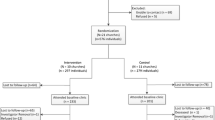Abstract
Objective: The impact of worksite intervention studies is maximized when reach and enrollment are high and attrition is low. Differences in reach, enrollment, and retention were investigated by comparing 2 different employee recruitment methods for a home-based cancer-prevention intervention study. Methods: Twenty-two worksites (N = 10,014 employees) chose either active or passive methods to recruit employees into a home-based intervention study. Reach (e.g., number of employees who gave permission to be called at home), Enrollment (e.g., number of employees who joined the home intervention study), and Attrition (e.g., number who did not complete the 12- and 24-month follow-ups) were determined. Analysis at the cluster level assessed differences between worksites that selected active (n =12) versus passive (n = 10) recruitment methods on key outcomes of interest. Employees recruited by passive methods had significantly higher reach (74.5% vs. 24.4% for active) but significantly lower enrollment (41% vs. 78%) and retention (54% vs. 70%) rates (all ps = .0001). Passive methods also successfully enrolled a more diverse, high-risk employee sample. Passive (vs. active) recruitment methods hold advantages for increased reach and the ability to retain a more representative employee sample. Implications of these results for the design of future worksite studies that involve multilevel recruitment methods are discussed.
Similar content being viewed by others
References
Glasgow RE, Vogt TM, Boles SM: Evaluating the public health impact of health promotion interventions: The RE-AIM framework.American Journal of Public Health. 1999,89:1322–1327.
Sorensen G, Emmons K, Hunt MK, Johnston D: Implications of the results of community intervention trials.Annual Review of Public Health. 1998,19:379–416.
Wilson M, Holman PB, Hammock A: A comprehensive review of the effects of worksite health promotion on health-related outcomes.American Journal of Health Promotion. 1996,10:429–435.
Jeffrey RW, Forster JL, French SA, et al.: The Healthy Worker project: A worksite intervention for weight control and smoking cessation.American Journal of Public Health. 1993,83:395–401.
Glasgow RE, Terborg JR, Hollis JF, Severson HH, Boles SM: Take Heart: Results of the initial phase of a worksite wellness program.American Journal of Public Health. 1995,85:209–216.
Sorensen G, Thompson B, Glanz K, et al.: Worksite based cancer prevention: Primary results from the Working Well trial.American Journal of Public Health. 1996,86:939–947.
Glasgow RE, McKaul KD, Fisher KJ: Participation in worksite health promotion: A critique of the literature and recommendations for future practice.Health Education Quarterly. 1993,20:391–408.
Resnicow K, Davis M, Smith M, et al.: Results of the Teachwell worksite wellness program.American Journal of Public Health. 1998,88:250–257.
Chapman LS: Maximizing program participation.The Art of Health Promotion. 1998,2(2): 1–8.
Crump CE, Earp JL, Kozma CM, Hertz-Picciotto I: Effect of or ganization-level variables on differential employee participation in 10 federal worksite health promotion programs.Health Education Quarterly. 1996,23:204–223.
Grosch JW, Alterman T, Peterson MR, Murphy LR: Worksite health promotion programs in the US: Factors associated with availability and participation.American Journal of Health Promotion. 1998,13:36–45.
Capaldi DM, Chamberlain P, Fetrow RA, Wilson JE: Conducting ecologically valid prevention research: Recruiting and retaining a “whole village” in multimethod, multiagent studies.American Journal of Community Psychology. 1997,25:471–492.
Bjornson-Benson WM, Stibolt TB, Manske KA, et al.: Monitoring recruitment effectiveness and cost in a clinical trial.Controlled Clinical Trials. 1993,14:52S-67S.
Altman D: Sustaining interventions in community systems: On the relationship between researchers and communities.Health Psychology. 1995,14:526–536.
Conrad K: Threats to internal validity in worksite health promotion research: Common problems and possible solutions.American Journal of Health Promotion. 1991,6:74–81.
Abrams DB, Boutwell W, Grizzle J, et al.: Cancer control at the workplace: the Working Well Trial.Preventive Medicine. 1994,23:15–27.
Prochaska JO, Redding CA, Evers KE: The transtheoretical model and stages of change. In Glanz K, Rimer B, Lewis F (eds),Health Behavior and Health Education (2nd Ed.). San Francisco: Jossey-Bass, 1997, 60–84.
Thompson B, VanLeynseele J, Beresford S: Recruiting worksites to participate in a health promotion research study.American Journal of Health Promotion. 1997,11:344–351.
Biener L, DePue J, Emmons K, Linnan L, Abrams D: Recruitment of worksites to a health promotion research trial.Journal of Occupational Medicine. 1994,36:631–636.
Emmons KM, Thompson B, Sorensen G, et al.: The relationen organizational characteristics and the adoption of workplace smoking policies.Health Education and Behavior.27:483-501.
Prochaska JO, DiClemente CC: Stages and processes of self-change of smoking: Toward an integrative model of change.Journal of Consulting and Clinical Psychology. 1983,51:390–395.
Greene G, Rossi S: Stages of change for dietary fat reduction over 18 months.Journal of the American Dietetic Association. 1998,98:529–534.
Greene GW, Rossi SR, Rossi JR, et al.: Dietary applications of the Stages of Change Model.Journal of the American Dietetic Association.99:673–678.
Rossi JS, Blais LM, Redding CA, Weinstock MA: Behavior change for reducing sun and ultraviolet light exposure: Implications for interventions.Dermatologic Clinics. 1995,13:613–622.
Marcus BM, Rossi JS, Selby V: The stages and processes of exercise adoption and maintenance in a worksite sample.Health Psychology. 1992,11:386–395.
Donner A, Klar N: Methods for comparing event rates in intervention studies when the unit of allocation is a cluster.American Journal of Epidemiology. 1994,140:279–289.
Prochaska JO: A stage paradigm for integrating clinical and public health approaches to smoking cessation.Addictive Behaviors. 1996,21:721–732.
Linnan LA, Abrams DB, Papandonatos GD, Emmons KE: Every Person Counts : Results of a randomized trial designed to increase employee participation in a comprehensive worksite health promotion program. Manuscript under review.
Thompson B, Bowen DJ, Croyle RT, Hopp HP, Fries E: Maxi mizing worksite survey response rates through community organization strategies and multiple contacts.American Journal of Health Promotion. 1991,6:130–136.
Sarkin JA, Marshall SJ, Larson KA, Calfas KJ, Sallis JF: A comparison of methods of recruitment to a health promotion program for university seniors.Preventive Medicine. 1998,27:562–571.
Lee RE, McGinnis KA, Sallis JF, Castro CM, Chen AH: Active vs. passive methods of recruiting ethnic minority women to a health promotion program.Annals of Behavioral Medicine. 1997,19:378–384.
Baker EA, Israel BA, Schurman SJ: A participatory approach to worksite health promotion.Journal of Ambulatory Care Management. 1994,17(2):68–81.
Heaney CA, Israel BA, Schurman SJ, et al.: Industrial relations, worksite stress reduction and employee well-being: A participatory action research investigation.Journal of Organizational Behavior. 1993,14:495–510.
Fisher E: Editorial: The results of the COMMIT trial.AmericanJournal of Public Health. 1995,85:159–160.
Abrams DB, Emmons KE, Linnan LA: Health behavior and health education: The past, present, and future. In Glanz K, Rimer B, Lewis F (eds),Health Behavior and Health Education (2nd Ed.). San Francisco: Jossey-Bass, 1997, 453–478.
Schensul JJ: Organizing community research partnerships in the struggle against AIDS.Health Education and Behavior. 1999,26:266–283.
Author information
Authors and Affiliations
Corresponding author
Additional information
Support for this work was provided by National Cancer Institute Grant P01 CA50087. Laura A. Linnan is now at the University of North Carolina-Chapel Hill School of Public Health.
We gratefully acknowledge thoughtful reviews provided by Glorian Sorensen and Graham Colditz on early drafts of this article. Special thanks to Michael Guertin for data preparation; to Mary Lynne Hixson, Suzanne Moriarty, and Sheila Jacobs for recruitment efforts; and to the 22 participating worksites in this study.
About this article
Cite this article
Linnan, L.A., Emmons, K.M., Klar, N. et al. Challenges to improving the impact of worksite cancer prevention programs: Comparing reach, enrollment, and attrition using active versus passive recruitment strategies. ann. behav. med. 24, 157–166 (2002). https://doi.org/10.1207/S15324796ABM2402_13
Issue Date:
DOI: https://doi.org/10.1207/S15324796ABM2402_13




